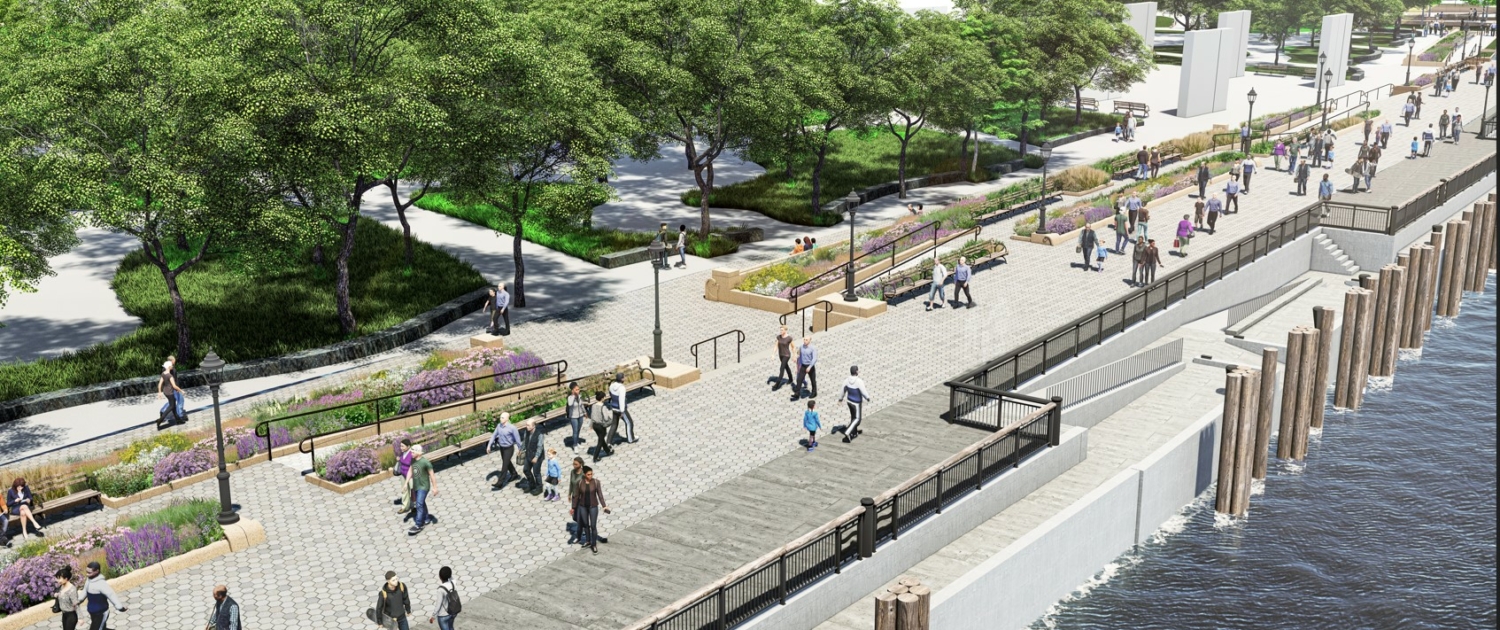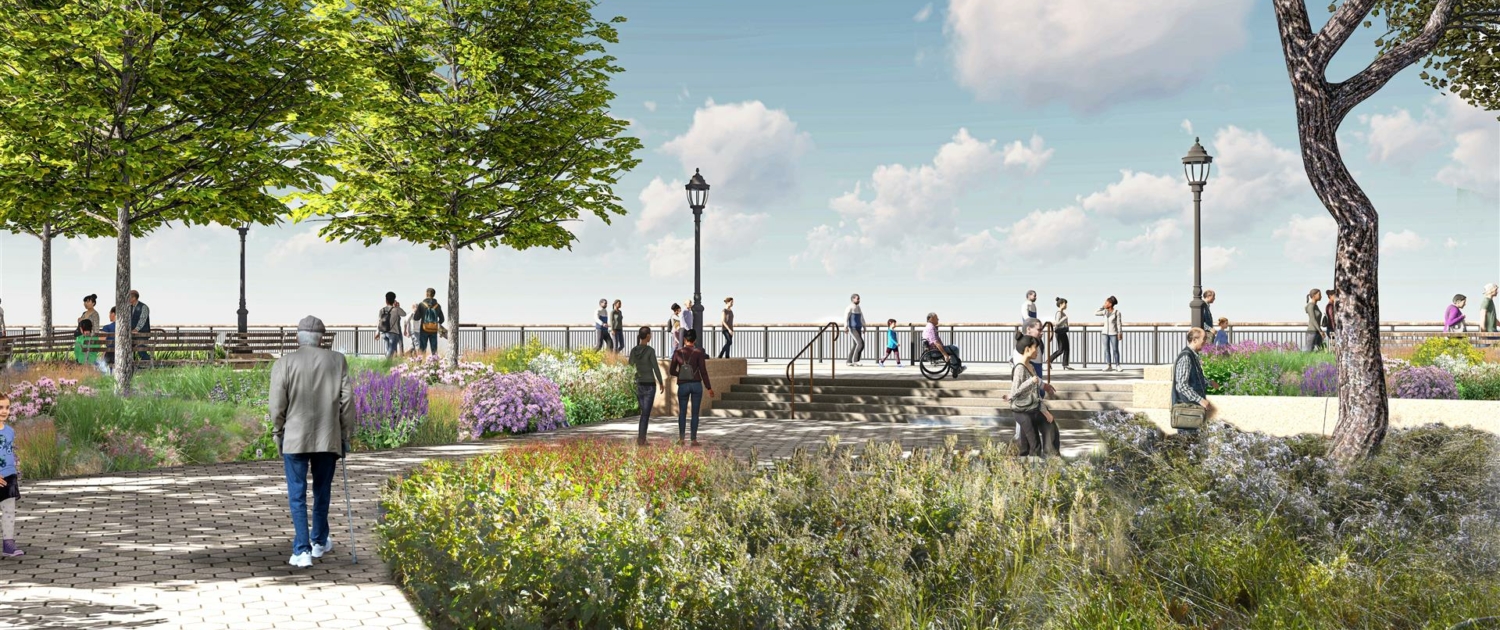Lower Manhattan Coastal Resiliency Project Earns Envision Platinum Award
3-April-2024
Washington, D.C. and New York City — The Lower Manhattan Coastal Resiliency – Battery project located in New York, New York, has earned an Envision Platinum award. This project is part of the larger Lower Manhattan Coastal Resilience initiative aimed at reducing flood risk from coastal storms and sea level rise. Led by the New York City Economic Development Corporation (NYCEDC) on behalf of the New York City Department of Parks & Recreation (NYC Parks) and the Mayors of Climate and Environmental Justice (MOCEJ), this project will rebuild the existing deteriorating wharf structure at a higher elevation to protect against sea level rise while integrating it with the iconic waterfront park at the southern tip of Manhattan.
The Battery is home to extensive gardens, artwork, and cultural landmarks and is the departure point for vessels taking thousands of passengers every year to the Statue of Liberty. The project will ensure the waterfront’s resilience over the next 80 years while promoting sustainable and resilient infrastructure in Lower Manhattan, a vital district of New York City. The Envision framework was used throughout the project’s development to track and improve sustainability performance. Exploring opportunities across key themes such as reducing embodied carbon, managing stormwater quantity and quality, and minimizing waste sent to landfills resulted in several innovative strategies. These strategies include reusing site materials, utilizing locally sourced and low-carbon materials, and investigating transportation alternatives that reduce emissions and pollutants.
Among the unique features of the wharf design is the multi-level slip design that provides universal access to vessels with varying freeboard heights for the wide range of sea level elevations at the wharf from the present day to 2100. This adaptive design provides flexibility for uncertain future conditions while preserving views of the Harbor, architectural details, and the character of the existing beloved park.
Material reuse and waste management were drivers of the design, which incorporates significant quantities of granite, metals, and wood from the existing site and provides a hierarchy for removals that prioritizes reuse and recycling and minimizes landfill waste. Plantings in the harsh waterfront environment were specified for salt tolerance and anticipated increasing urban heat, while maintaining the colorful perennial variety throughout the seasons that characterizes the larger park design.
The project will contribute to long-term community goals by addressing the impending sea level rise, restoring the wharf conditions for continued safe usability, and preserving The Battery’s iconic and historic character. Construction is being divided into two phases of partial wharf closures to minimize disruptions to park and ferry activity to and from Liberty and Ellis Islands, with project completion targeted for 2026.
Verified Sustainability Achievements
Address Climate Change Vulnerability – In 2012, Hurricane Sandy devastated New York City, flooding 17% of the land and claiming 43 lives. The storm affected 400 buildings, impacted transportation assets, interrupted power supply, closed parks, released 5.2 billion gallons of untreated sewage into the city’s waterways, and ultimately caused $19 billion in damages. After the storm, the Lower Manhattan Climate Resilience Study assessed the vulnerability of the community to climate change by identifying climate hazards (sea level rise, groundwater table rise, storm surge, extreme precipitation, and heat waves) and mapping them against the city’s infrastructure systems. The study identified five key projects in the Lower Manhattan Coastal Resiliency program that would improve the community’s resiliency against these climate threats. The five projects, including the Battery Coastal Resilience, will comprise a connected network of infrastructure projects along Lower Manhattan’s waterfront to improve the community’s resiliency to a changing climate. The project team’s emphasis on improving resilience was recognized with high levels of achievement across this Envision achievement area.
Climate Adaptive Design – One of the most unique aspects of the project is the slip design which integrates the elevated waterfront platform, designed for future sea level rise conditions, with ferry access points, designed for current sea levels and vessel operations. The innovative multi-level slip design allows for flexibility over the near and long-term operations of the wharf by considering daily tidal swings, varying sized vessel berthing, accessibility, and sea level rise, balanced with maintaining the park’s character and waterfront experience. The slip design is easily able to be adapted for future sea level rise conditions with higher platforms integrated into the existing design, limiting disruptions to long-term wharf operations while meeting current and future wharf needs.
Embodied Carbon Reduction – Early in design, NYCEDC and NYC Parks established a sustainability charter that included the goal to quantify and reduce the overall embodied carbon emissions of the project. To further this goal, Stantec developed an embodied carbon baseline to help the project team understand the major material contributors to the project’s emissions sources. Stantec’s Climate Solutions team also developed embodied carbon-based procurement for concrete and a tool that would allow construction partners to calculate the Global Warming Potential (GWP) of their concrete mixes to stay within a defined GWP budget. The project’s construction partner, Hunter Roberts, identified opportunities to use alternative modes of transportation such as barging material and equipment to site that would reduce carbon emissions and take trucks off congested New York City streets. In the end, the project team estimates a 54% reduction in embodied carbon emissions compared to the baseline.
Sustainable Resource Management – The project team used the Envision framework as a roadmap to organize sustainability initiatives, track performance, and assign task responsibility. Among these key initiatives is the implementation of amaterial management plan centered on reducing environmental impacts related to the extraction, refinement, and transport of construction materials. Strategies included reusing existing materials, using less materials, using recycled materials, and selecting more sustainable alternatives. Guided by this approach, the team selected a recycled fill material that significantly reduced the project’s embodied carbon in comparison to typical engineered fill materials. These earthwork improvements resulted in an estimated $3 million savings for the project. Additionally, the project will divert at least 75% of its nonhazardous construction waste from landfills to instead be reused, recycled, or otherwise salvaged.
Enhanced Public Space & Restored Artwork – The Battery is one of New York City’s signature parks — home to several historic and cultural resources, offering iconic views of the Hudson and East Rivers, and providing ferry access to the Statue of Liberty. To protect and enhance the park’s defining characteristics, the project team consulted with a variety of community stakeholders, including New York’s State Historic Preservation Office (SHPO), the Stockbridge-Munsee Indigenous Group, the Maritime Association of New York, the National Park Service, and even original artists. Together, they identified and evaluated the resources that may be impacted by this project and developed a plan to preserve and revitalize them. Continuous consultation with community stakeholders also led to the development of plans to improve pedestrian accessibility throughout the park, update public seating to better enjoy the views, and preserve existing trees and gardens.
Quotes
“The Lower Manhattan Coastal Resiliency (LMCR) project sets the standard for future projects of this kind, marrying coastal protection with an ambitious sustainability agenda,” said New York City Economic Development Corporation (NYCEDC) President & CEO, Andrew Kimball. “NYCEDC is proud of LMCR and the teams involved for receiving the Envision Platinum Award all in an effort to create a cleaner, greener New York City.”
“With sea levels rising and storms growing stronger and more frequent, it is vital that we invest in protecting our city from the effects of climate change,” said Sue Donoghue, Commissioner of New York City Department of Parks and Recreation. “Our innovative plans for the Battery are helping to ensure that the Lower Manhattan waterfront is well-prepared for the 21st century’s extreme weather and rising tides, without sacrificing New Yorkers’ access to this historic and beloved greenspace. The challenges of climate change affect cities across the country and around the world, and I’m so proud that New York City is setting an example with this creative and exciting approach, which rebuilds our critical infrastructure while minimizing waste and utilizing local, recycled materials.”
“As New York City advances coastal resilience projects in a dense urban environment, it is essential that we minimize harmful emissions from our construction and waste sent to landfills,” said Mayor’s Office of Climate & Environmental Justice Executive Director, Elijah Hutchinson. “With NYCEDC’s Envision Platinum Award, the city has met and exceeded our Clean Construction Accelerator goal of reducing embodied emissions in infrastructure projects by 50%.”
“The Battery protected Manhattan against threats from the sea when its shoreline forts deterred foreign navies,” explained Warrie Price, President and Founder of The Battery Conservancy. “Today, The Battery is called to serve again – to defend the city we love from the sea itself. The Battery Conservancy is proud to work with New York’s leadership to ensure that this storied public space will continue to attract and comfort water-gazers and garden-lovers.”
“With The Battery’s rich history and cultural significance, this project demanded a holistic approach to sustainable and resilient design,” remarked Greg Sprich, Principal at Stantec Consulting Services Inc. “The team rose to the challenge and delivered a project that not only provides much needed coastal protection to lower Manhattan, but also serves as a case study for reducing waste and embodied carbon for future infrastructure projects.”
“Resilient and sustainable environments are the result of collective effort and vision, which is at the core of the Lower Manhattan Coastal Resiliency – Battery Project,” said Ethan Smith, Project Manager and Envision Lead at Hunter Roberts Construction Group. “This award recognizes the extensive planning, design, and coordination efforts made by the team to showcase sustainable, resilient infrastructure and green construction practices.”
“As communities invest in infrastructure projects, it’s crucial to incorporate sustainable and resilient features that account for the projected impacts of climate change,” said Kristi Wamstad, ISI Verification Director. “This project is an outstanding demonstration of how a project team can successfully work with a variety of community stakeholders to assess infrastructure vulnerability and use the Envision framework to plan for resiliency.”







